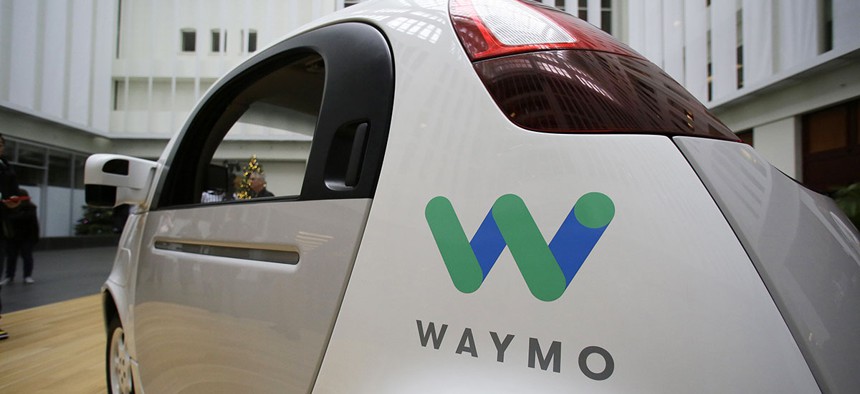The Most Important Self-Driving Car Announcement Yet

Eric Risberg/AP File Photo
Autonomous vehicles will transform urban life by 2020, if Waymo’s time line is correct.
On Tuesday, Waymo announced they’d purchase 20,000 sporty, electric self-driving vehicles from Jaguar for the company’s forthcoming ride-hailing service.
Waymo, Google’s sister company within Alphabet, held a press conference in New York for the unveiling of the vehicle, and most of the stories revolved around the luxury SUV’s look and feel.
But the company embedded a much more significant milestone inside this supposed announcement about a fancy car. With orders now in for more than 20,000 of these vehicles and thousands of minivans that Chrysler announced earlier this year, Waymo will be capable of doing vast numbers of trips per day. They estimate that the Jaguar fleet alone will be capable of doing a million trips each day in 2020.
You could quibble with their math (will it really be that many daily trips per car?) or their overall utilization rate (how many cars will be lost to maintenance per day?), but if Waymo is even within 50 percent of that number in two years, the United States will have entered an entirely new phase in robotics and technology.
The company’s autonomous vehicles have driven 5 million miles since Alphabet began the program back in 2009. The first million miles took roughly six years. The next million took about a year. The third million took seven months. The fourth million took six months. And the fifth million took three months. Today, that suggests a rate on the order of 10,000 miles per day. If Waymo hits their marks, they’ll be driving at a rate that’s three orders of magnitude faster in 2020. We’re talking about covering each million miles in hours.
But the qualitative impact will be even bigger. Right now, maybe 10,000 or 20,000 people have ever ridden in a self-driving car, in any context. Far fewer have been in a vehicle that is truly absent a driver. Up to a million people could have that experience every day in 2020.
2020 is not some distant number. It’s hardly even a projection. By laying out this time line yesterday, Waymo is telling the world: Get ready, this is really happening. This is autonomous driving at scale, and not in five years or 10 years or 50 years, but in two years or less.
When Waymo starts to hit the big numbers, it will be a watershed moment not just for self-driving cars but for artificial intelligence in general. If people suddenly have thousands of robots driving among them, what else will they become comfortable—or uncomfortable—with robots doing?
At the same time, the questions that Waymo needs to answer are changing. Up to this point, the primary point of emphasis among journalists and other interested observers has been technological: Does the self-driving car work?
And there are subsidiary questions that run down from there: Which sensors create the best data? How is that data integrated into a model of the world? What algorithms are best for choosing a route? What kinds of tests generate the most useful new data? What simulation software can accelerate real-world learning the fastest? What are the modes of failure?
These are the questions that the killing of a pedestrian in Arizona by an Uber self-driving vehicle has raised with new intensity. No self-driving car should have missed that pedestrian crossing the road. For whatever version of Uber’s self-driving system that was being tested that day, the answer to the question “does it work?” was a simple no.
But for Waymo’s program, that line of questioning is becoming a red herring. Waymo is not spending a billion dollars on cars for a fleet because they are not sure if their technology works. It works well enough to begin rolling it out to a million people a day. Waymo cars will most certainly get in accidents. They will kill people, too. But everything about Waymo’s program suggests that they think their cars are substantially safer than human drivers.
For years, people asked questions of Facebook that were about their technology and business. Can it scale? Will they be able to monetize? But when it turned out that, yes, it could scale, and yes, they would have 75 percent gross margins, the next set of questions had not received proper attention. For example, what does rewiring the world’s political systems through Facebook mean for democracies? What should Facebook’s relationship to political candidates and governments be?
It wasn’t that scholars and journalists hadn’t asked the questions, but the vast majority of people reacted to the technology as consumers (or purchasers of stocks), not as citizens.
With Waymo’s most recent announcement, now is the time to think through these larger questions. They are bigger and harder because they cannot be answered by technological proof. They involve power—Alphabet’s power, the power of labor, the power of local governments to control their jurisdictions.
Let’s assume Waymo is wildly successful. They take over the ride-sharing market from human drivers in both ride-hailing companies and traditional taxicabs. In so doing, they’ll complete the shift in consumer spending on car transportation from thousands of taxicab drivers across thousands of cities to one technology company. It’s not unlike thousands of newspapers making money from classifieds and then a couple of technology companies taking all of that revenue. It’s certainly easier to buy stuff from other people now, but local journalism is in a hopeless business situation.
Or let’s say that Berkeley, California, declares itself a “robocar-free zone.” Will Waymo have to respect that ordinance or will it—as Uber did—operate first and deal with local governments later?
Or let’s say that Waymo’s cars prove to be vastly safer than human drivers, orders of magnitude better. At that point, what mechanisms might governments use to coax human drivers out of cars?
Or take my colleague Ian Bogost’s all-too-real vision of the necessity of accepting the use of your travel data for targeted advertising in order to catch a ride. “It’s easy to imagine that crosstown transit might soon require acceptance of nonnegotiable terms of service that would allow your robocar provider to aggregate and sell where you go, when, with whom, and for what purpose,” he wrote.
Or consider Bogost’s scenario in which autonomous-vehicle companies come to support the maintenance of roads with private dollars, but at the cost of losing the public right-of-way. “Given the opportunity, autonomous-car services will likely be willing to invest heavily in redeveloping urban infrastructure that would give them an economic advantage in serving the populations that live there,” he wrote. “Especially if it would mean a monopoly on local transit. The results could change city life entirely.”
That’s why Waymo’s announcement is the biggest since Google indicated it had functioning self-driving cars on California roads. Self-driving cars are a technology that may destroy the 20th-century American city as human-driven cars destroyed the 19th-century city. Let’s just say things didn’t work out perfectly last time. We ended up with sprawling, segregated, wasteful cities. Commute times continue to rise. Lively street life is a luxury that’s usually reserved for the wealthy.
Here’s the chance to rethink the role of wheeled transportation and urban life. And Waymo just gave us the timeline.
NEXT STORY: Can a Mobile App Stop Veteran Suicides?



